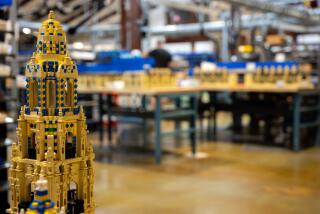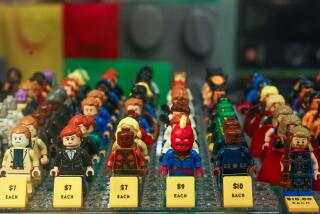Life’s Simple Pleasures : Recreation: Lego toys leave flash to others. Their enduring popularity among kids and adults is built brick by brick.
- Share via
Two young brothers cruise the aisles of the Toys R Us in Culver City, whipping past the G.I. Joes and trolls, the Ninja Turtles and X-Men to the stacks of Lego sets.
“Awesome,” exclaims the older boy as he climbs up the shelves to grab a set featuring medieval knights and a glow-in-the-dark ghost. “We should really get that one,” he says.
“Let’s go ask Mom.”
If she’s in a spending mood, Mom probably will probably succumb. Maybe she won’t mind yet another box of the interlocking plastic bricks strewn across her living room. After all, they’re virtually unbreakable and (in theory) nonviolent. And if the truth be told, thousands of adults are secretly addicted.
Consider: When the grown-up employees of a Manhattan advertising agency spent a week last year tinkering with toys as part of an independent stress-reduction experiment, they tried Super Soakers, Koosh Balls and Play-Doh, among other items. But Lego bricks were rated as a favorite by those trying to reach that high plane of consciousness where forms in triplicate, missed deadlines and time cards have no place.
So what’s the big deal? Unlike Barbie dolls, the turtles or one of this year’s big sellers, trolls, brightly colored Lego toys have no recognizable character, no mascot, no permanent structure. And it’s not the fanciful themes and multicultural figures, pastel-colored “girls” sets, an international model-building competition, computer software and theme parks--one in Denmark and another planned for Carlsbad--that fuel the plastics factory.
No, the real lure of Lego toys, most users say, is their simplicity.
Long a giant in Europe, particularly Germany, Lego bricks are among the top five best-selling toys, excluding video games, in the United States, according to David Miller, president of the Toy Manufacturers of America.
The toy, which Lego Systems Inc. calls “a creative basic material,” largely consists of 1,600 different plastic parts sold in some 200 different sets ranging in price from as little as $6 to more than $100. Using these components, Legophiles can build anything from a preschooler’s simple stack to a museum-quality architectural model--then dismantle it and build something else.
A carpenter named Ole Kirk Christiansen created the first Lego toys more than 60 years ago in Billund, Denmark, about 120 miles from Copenhagen, where the company maintains its world headquarters in a sleek and decidedly grown-up building. Christiansen gave his toys--initially hand-painted wooden cars and animals and then, in 1949, the company’s trademark bricks--the name Lego, a contraction of the Danish leg godt, or “play well.”
It seems to fit.
“Kids like to build things in an unconstrained way,” explains Seymour Papert, a professor of learning theory at Massachusetts Institute of Technology. “Mud pies are pretty unconstrained. And kids like to make mud pies, but (the pies) have no structure and you can’t bring them in the house.”
Because players can build almost anything from a few simple bricks, Lego is “a very powerful, provocative toy,” he says.
Papert ought to know. His official title is--seriously--Lego professor of learning research, an endowed post he earned five years ago after using one of his inventions--a computer programming language called Logo to automate the construction toy.
The offspring of Logo and Lego is Lego TC Logo, software designed to automate models built from Lego bricks, along with gears, lights and motors that talk to the computer via wires and sensors.
Students at Corona Avenue Elementary School in Bell have used the software to program a Lego robot to negotiate a maze outlined with tape on the floor. Children ages 8 to 10 with little or no programming experience also built and automated a Lego carnival, operating the Ferris wheel and other miniature attractions, turning lights on and off and calculating the park’s operating expenses.
“This is one of the best hands-on things I’ve used” as a learning tool, says teacher Karen Hare.
Hare’s colleague at Corona, Jack Baumann, says the bricks alone help non-English-speaking students learn. As his students work in teams to build towns, their vocabulary expands. Trouble is, Baumann says, “the kids sometimes get so excited about their constructions that I have to remind them to speak in English.”
In recent years, Lego Systems has found new ways to capitalize on that kind of excitement. The 6-year-old Lego Builders Club, confined to the English-speaking market, has 120,000 U.S. members, and another 110,000 in Britain and Canada. They receive a quarterly newsletter with instructions for building special models, contest entry forms and product announcements.
The ultimate contest is the Lego World Cup, held every four years. Last summer, 29 finalists, boys and girls ages 3 to 14 from 12 countries, competed at Legoland in Billund. Working with an identical pile of bricks, each had two hours to build an entry.
Thomas Michon of Irvine, then 5, won in his age group for a monorail system model. He says he still builds with his 50,000 or so Lego bricks “every day” and looks forward to using one of his prizes, a lifetime free admission to Lego theme parks, when the Carlsbad site opens in 1999.
Company officials say the plans for the San Diego County attraction include model villages and towns from around the world, a theater and shows, “extensive opportunities for creative play with Lego bricks,” but no thrill rides. Similar forms of low-tech amusement drew 1.2 million visitors last year to the Billund Legoland.
But perhaps a bigger priority for the company than its new park is eliminating the gender gap. The bricks have historically appealed more to boys than girls, particularly among the post-preschool set, says John F. Dion, spokesman for Lego’s U.S. headquarters in Enfield, Conn.
In hopes of convincing girls that Lego toys can be as fun as Barbie, Lego adopted a time-honored strategy: It turned pink. Its Paradisa line features resort and household scenes, more female figures, and lots of pastel pink and mint-green bricks.
Dion and his Danish colleagues say the bricks’ traditional primary colors did not appeal to girls as they grew older. And while the company does not release sales figures, it claims Paradisa sets are selling not only well to girls but also to boys.
Not everyone in Lego land agrees on the pink strategy. Some company executives in Billund thought it “went too far,” says Peter Ambeck-Madsen, senior public information manager there.
Papert agrees, arguing that Paradisa models “pander to the gender difference rather than understand it.”
But he acknowledges that boys and girls strongly differ in the way they play with Lego and other construction toys. Boys tend to use his computer software to make “noisy trucks” with sirens, lights and moving wheels. They will offer to trade their plain bricks to the girls for extra motors.
The girls, in turn, use those extra bricks to build more grandiose houses or large animals; they often have trouble figuring out how to incorporate electronic gadgetry, Papert says. Yet with a bit of encouragement, the girls add lights to their houses--even a spinning Christmas tree--or program, say, a Lego cat to move toward a Lego kitten when it emits an electronic “meow.”
Papert suggests that retooling instruction sheets and idea books to address the way girls play, might offer girls a “better mode of access” to the toy, and provide more interest, than a simple color change.
Although the bricks appeal primarily to children, plenty of adults have succumbed to “Legomania.” Many of the adult Builders Club members are architects and engineers who build models for relaxation.
More than a few adults get hooked while cleaning up after their children.
Philip Clay, an Australian businessman who travels regularly to Los Angeles, recently went shopping for Lego sets for his sons. However, 8,000 miles from home, he was hard-pressed to recall which sets his kids had and which they wanted. But he did remember the mess the bricks make. So he settled on Lego’s Polly Pick-Up, a contraption that collects loose bricks when rolled across the floor. The toy promises to make clean up “fun.”
That was good enough for Clay.
More to Read
The biggest entertainment stories
Get our big stories about Hollywood, film, television, music, arts, culture and more right in your inbox as soon as they publish.
You may occasionally receive promotional content from the Los Angeles Times.










